Luận án Mô hình đặc tính kênh truyền cho thông tin thủy âm vùng nước nông
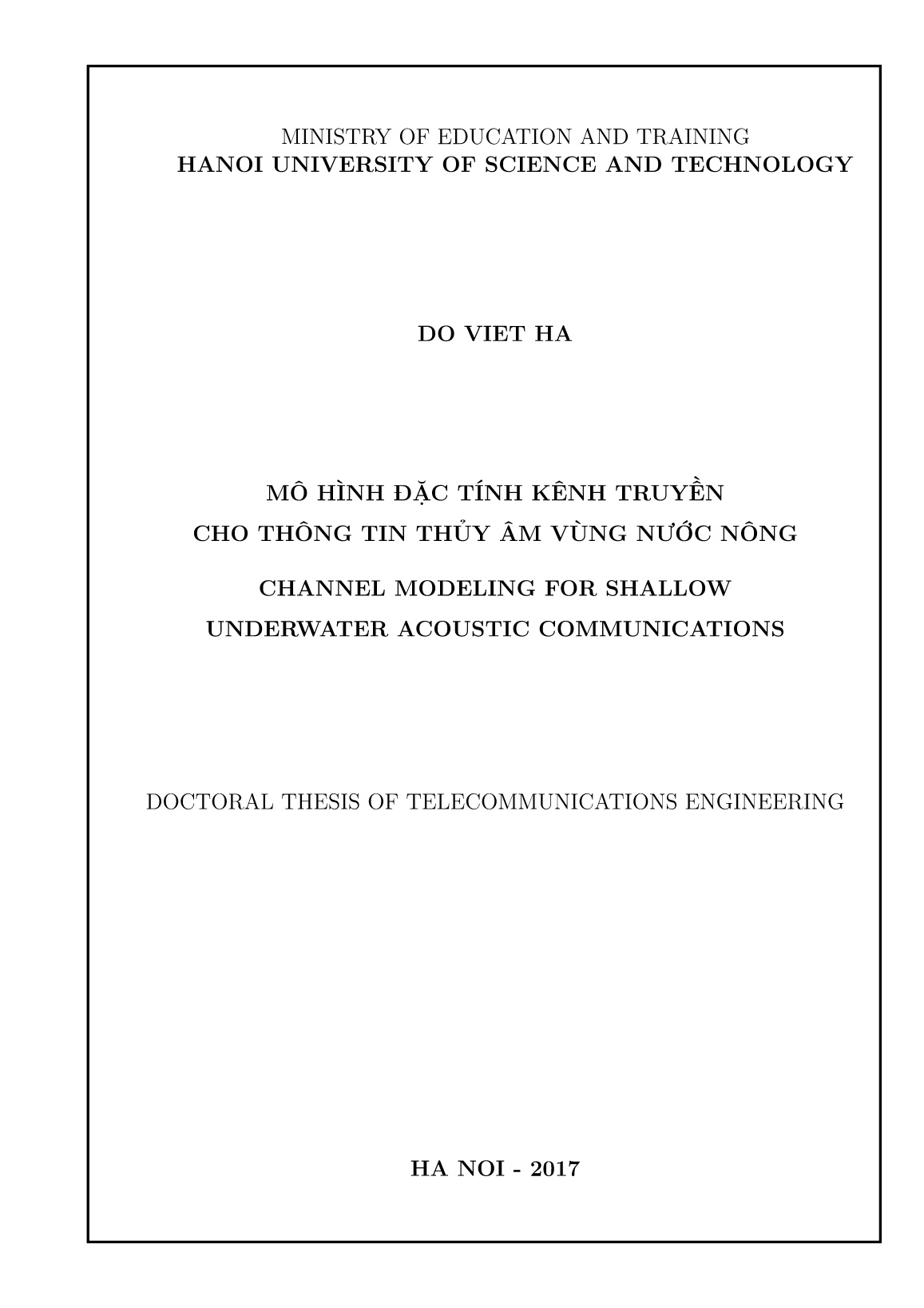
Trang 1
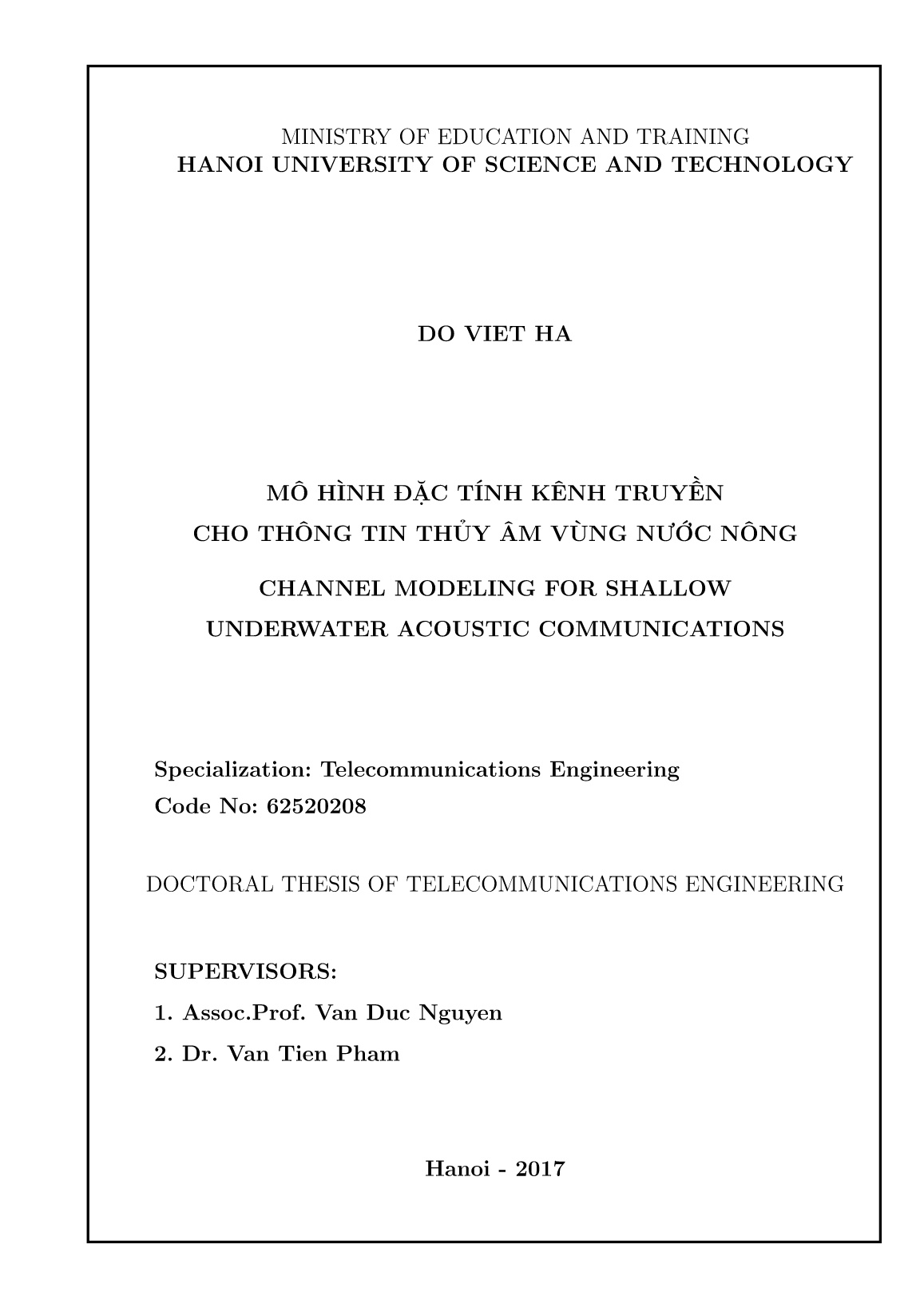
Trang 2
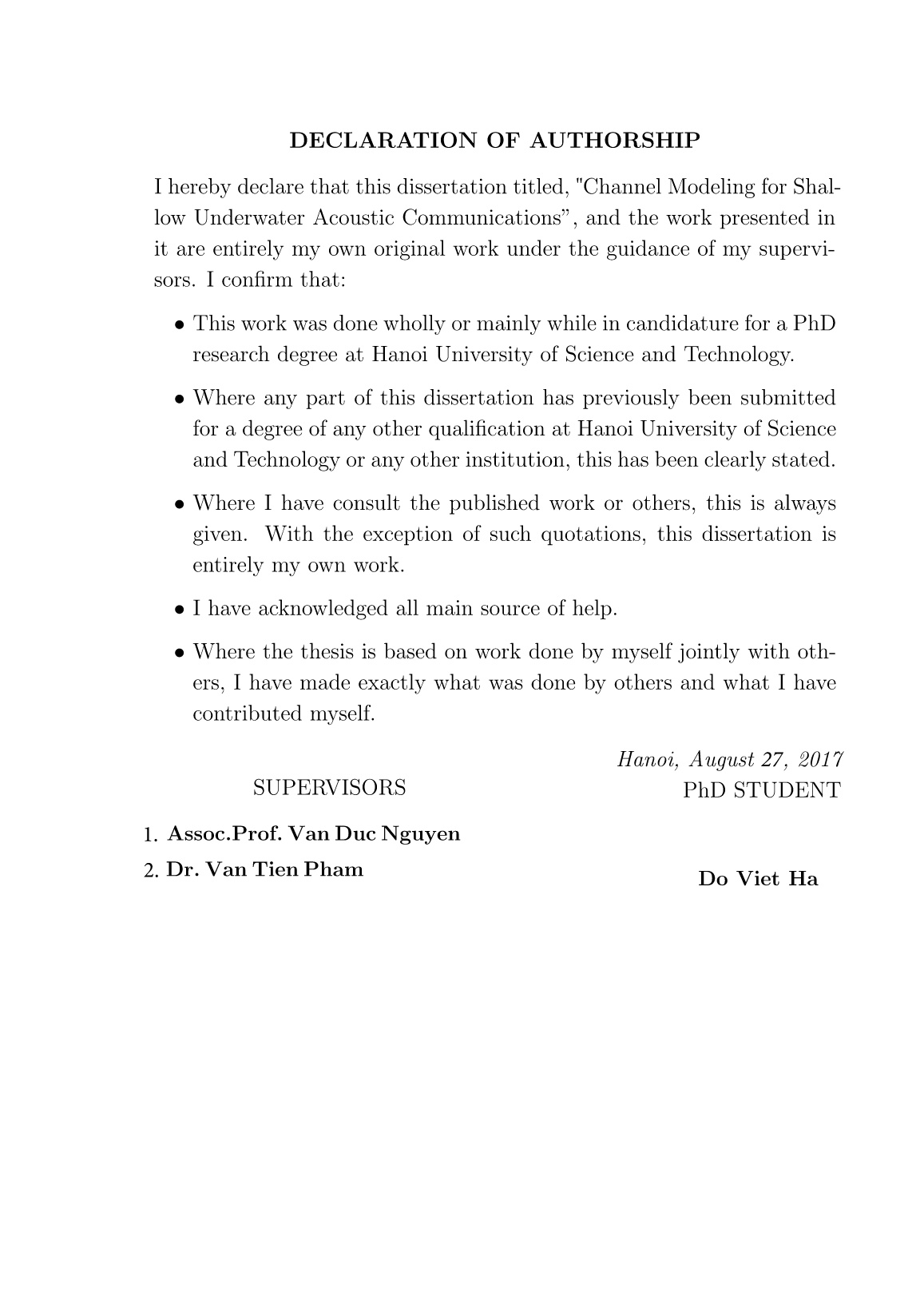
Trang 3
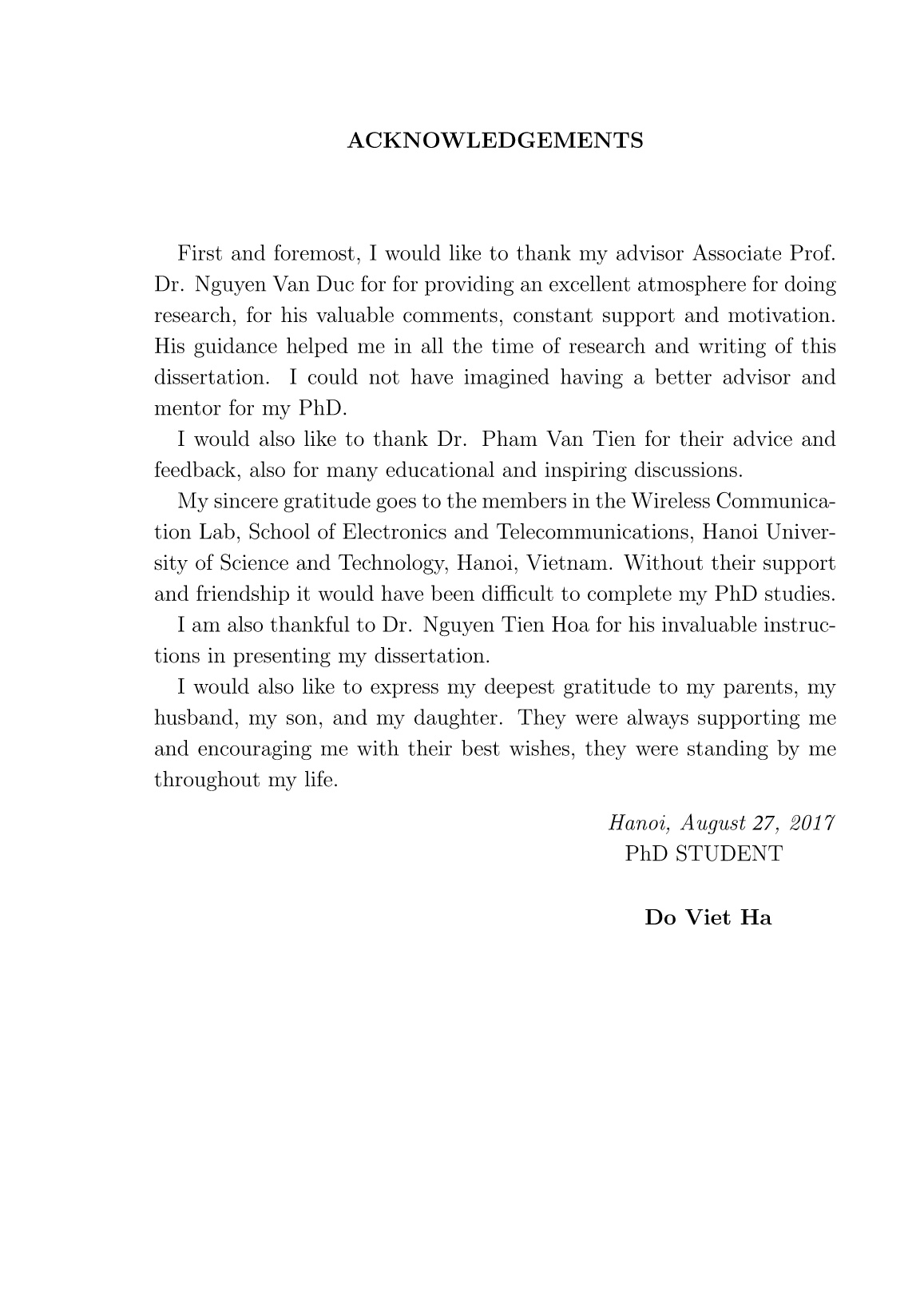
Trang 4
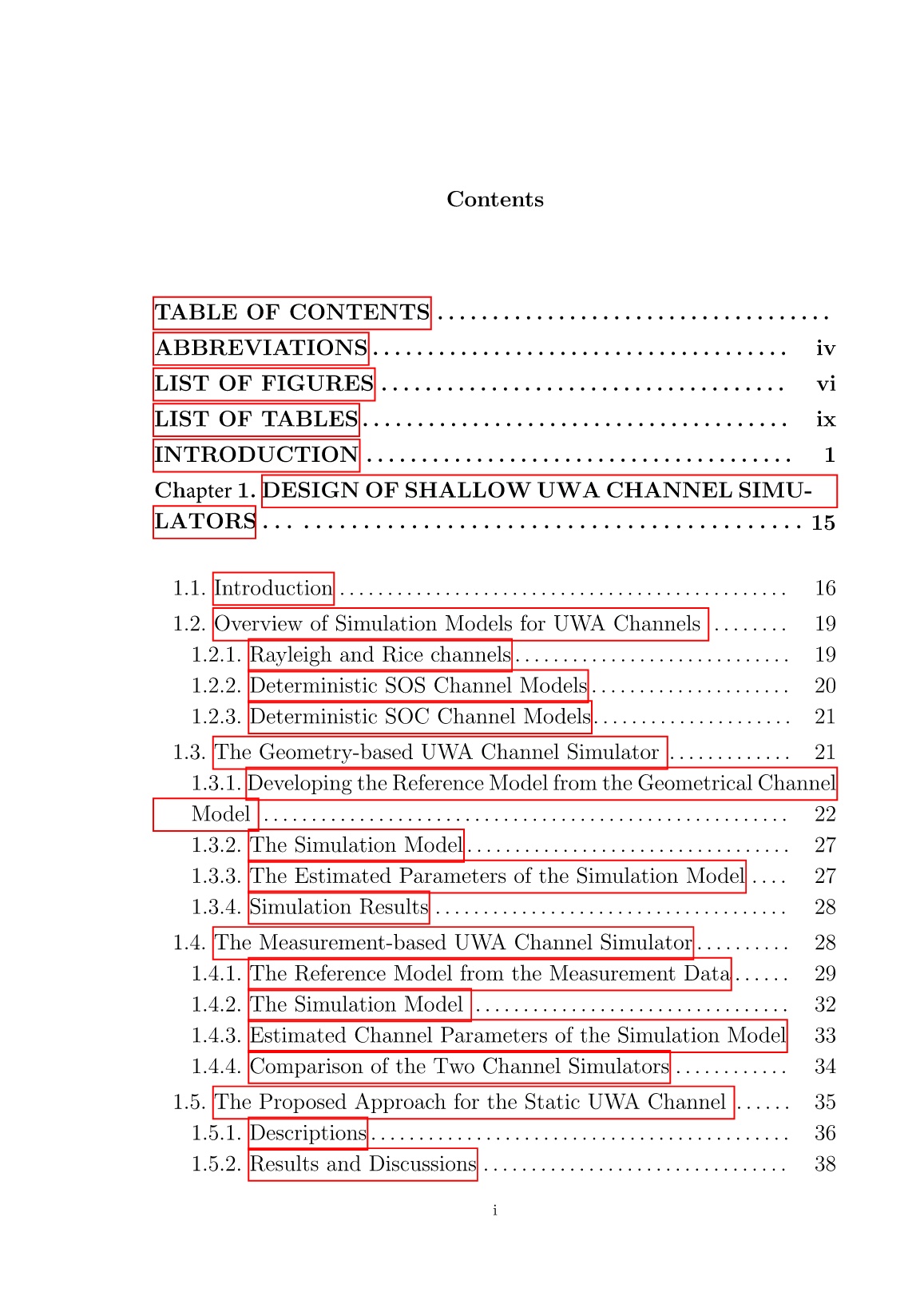
Trang 5
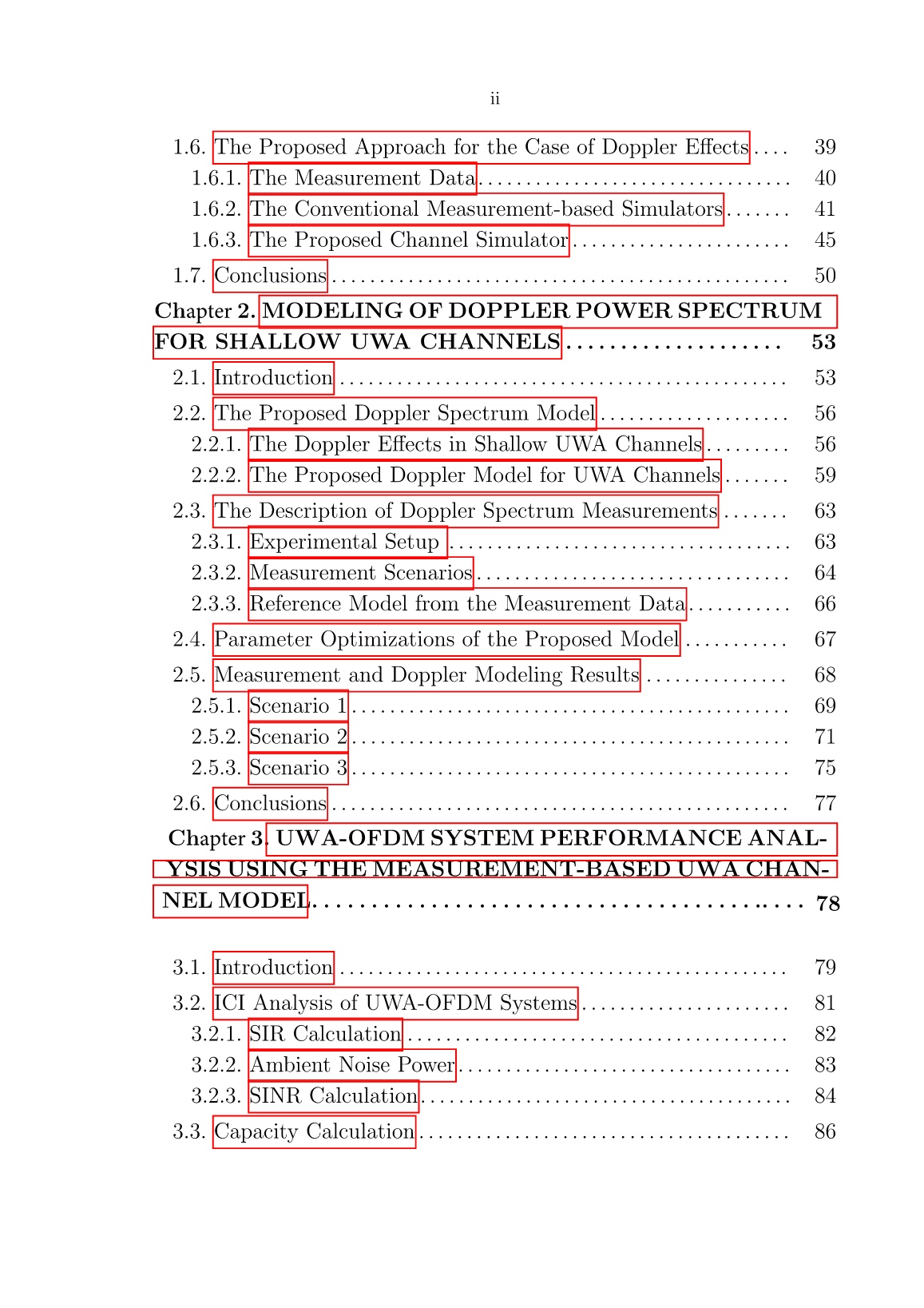
Trang 6
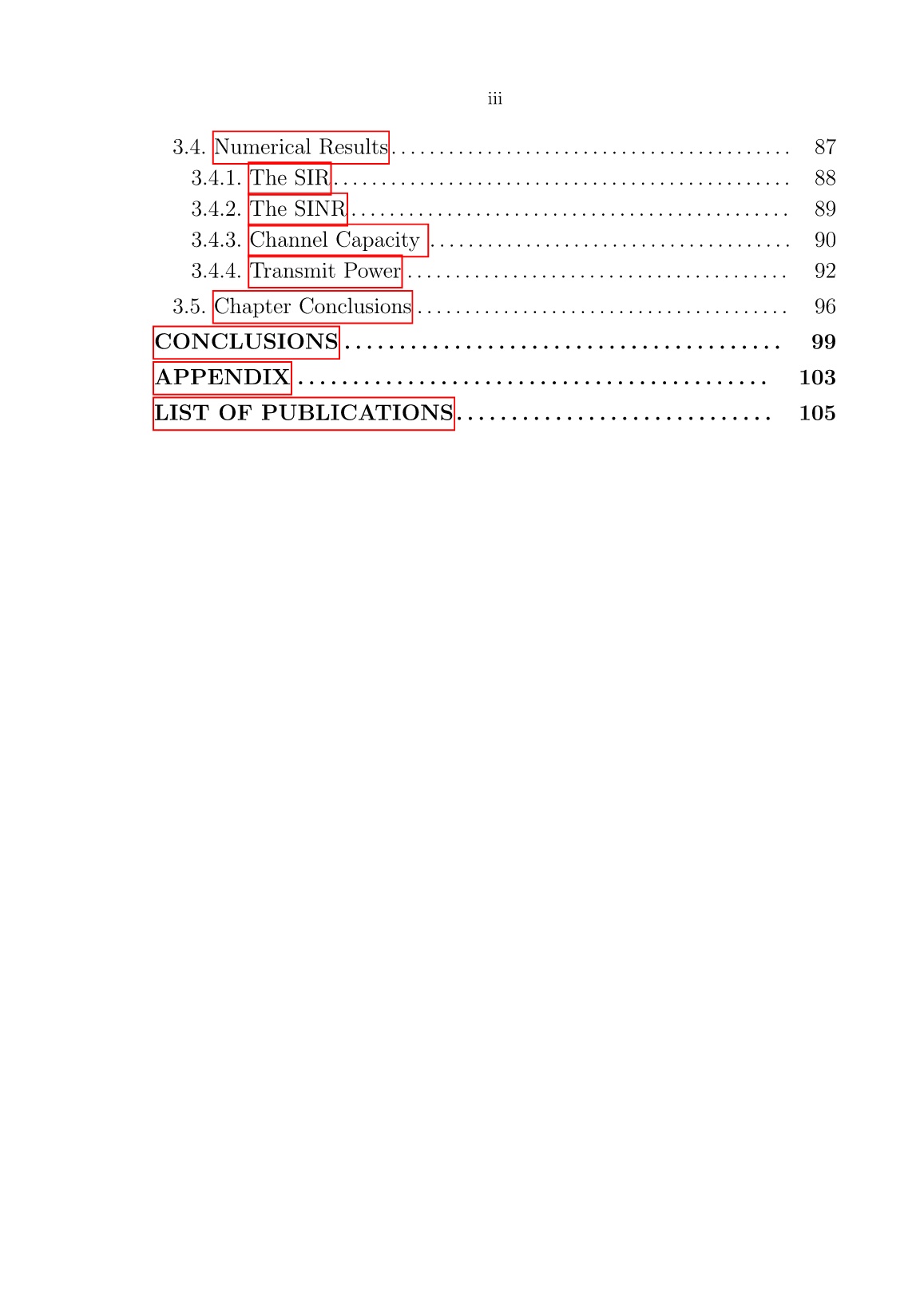
Trang 7
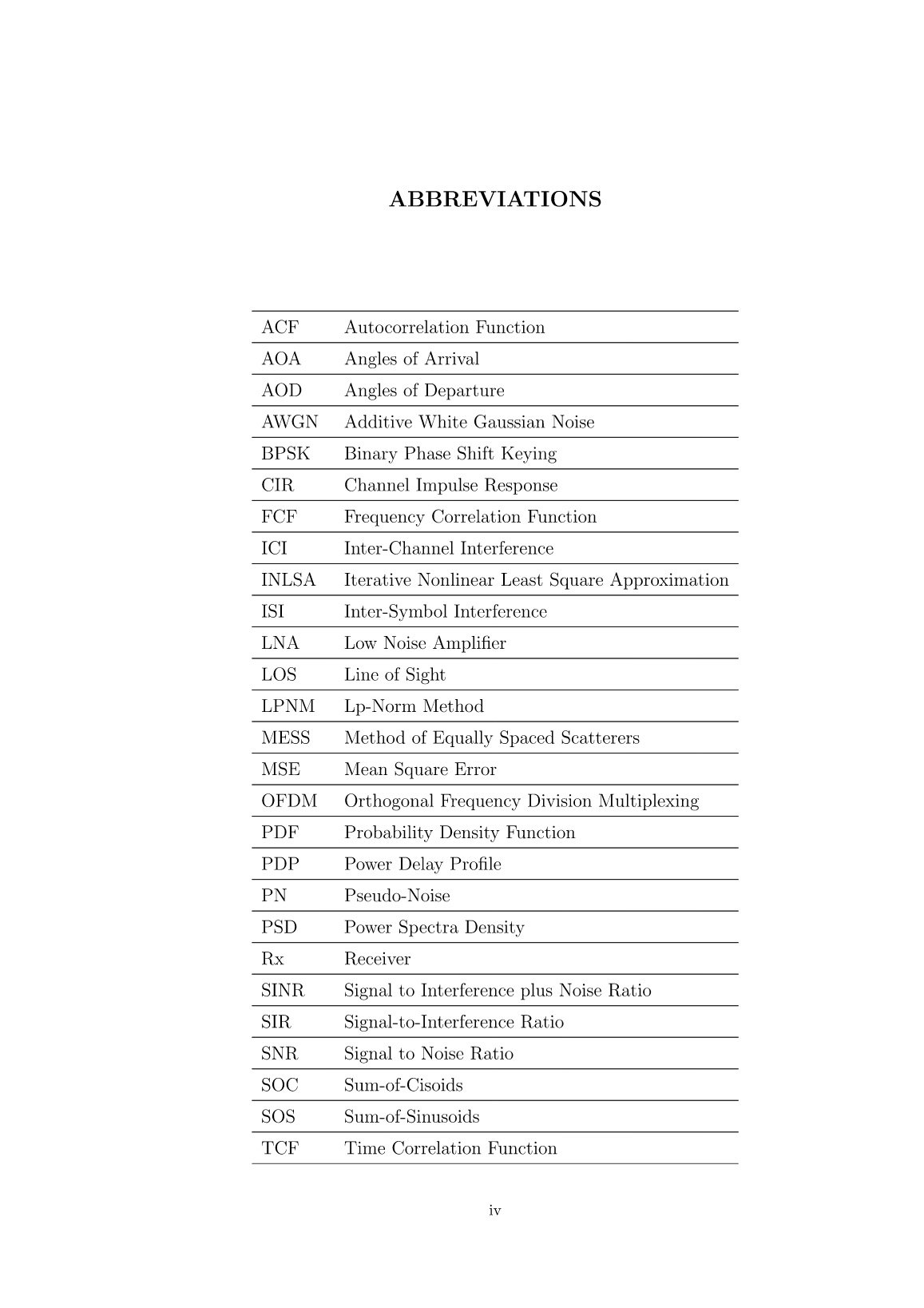
Trang 8
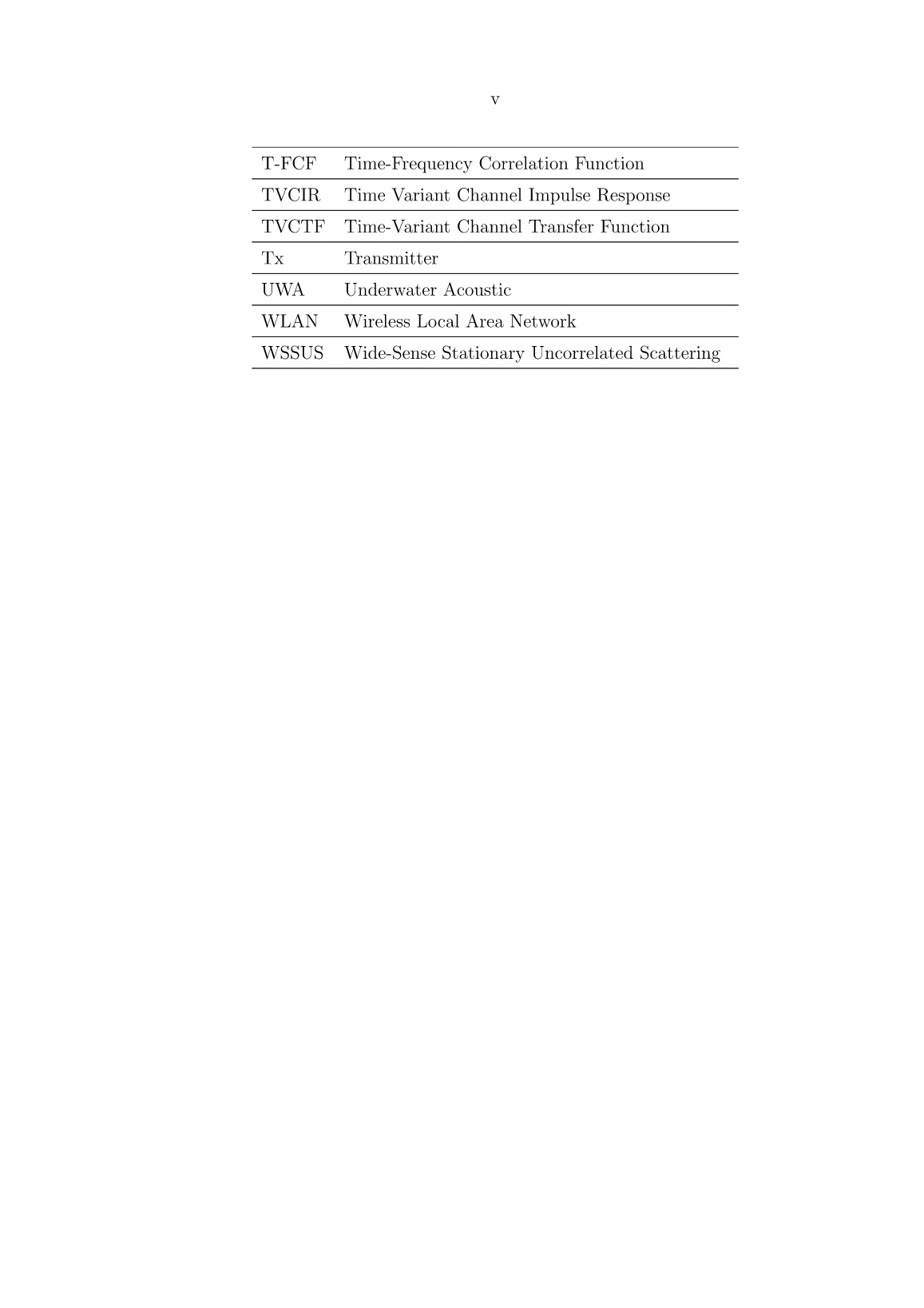
Trang 9
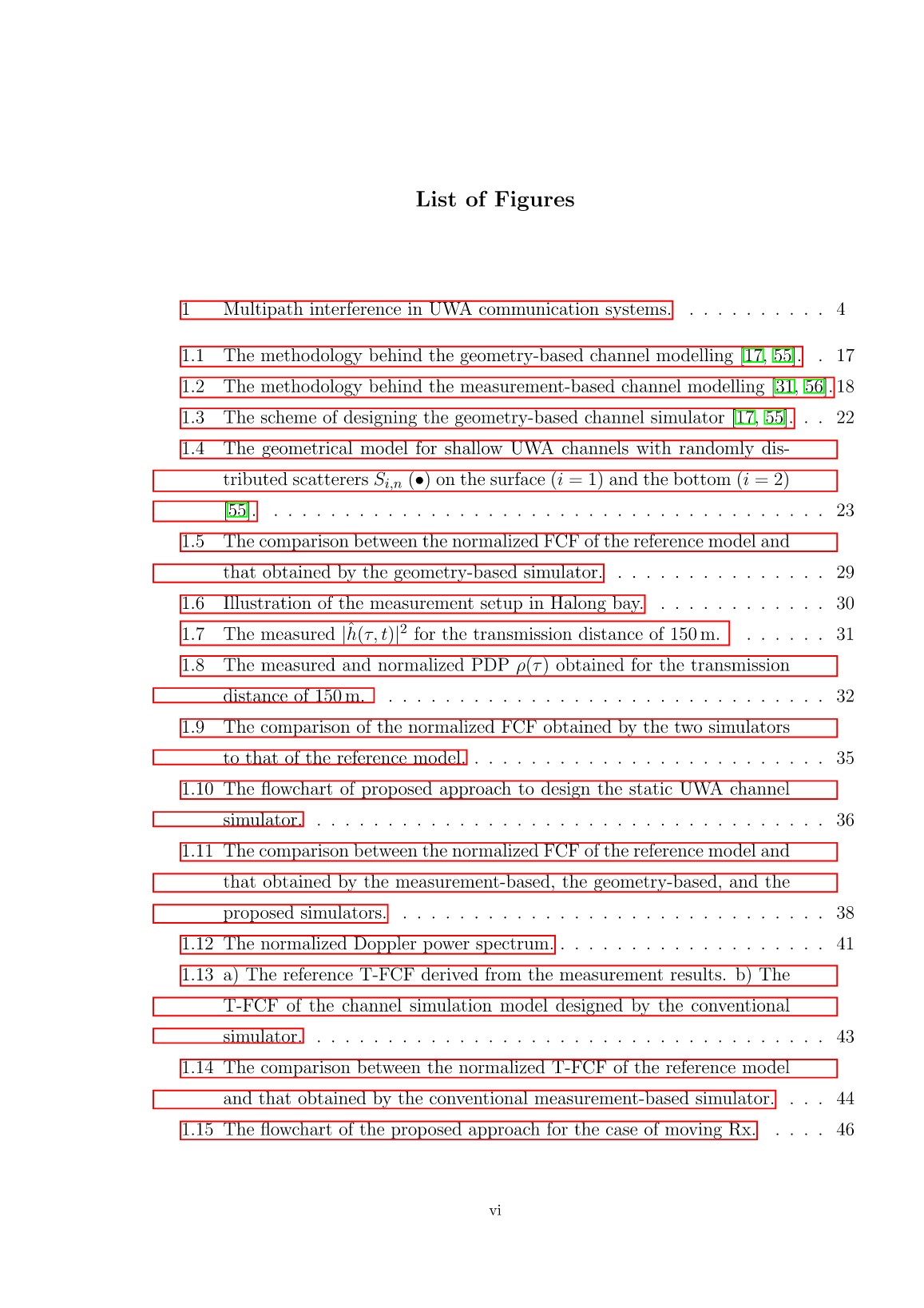
Trang 10
Tải về để xem bản đầy đủ
Bạn đang xem 10 trang mẫu của tài liệu "Luận án Mô hình đặc tính kênh truyền cho thông tin thủy âm vùng nước nông", để tải tài liệu gốc về máy hãy click vào nút Download ở trên.
Tóm tắt nội dung tài liệu: Luận án Mô hình đặc tính kênh truyền cho thông tin thủy âm vùng nước nông
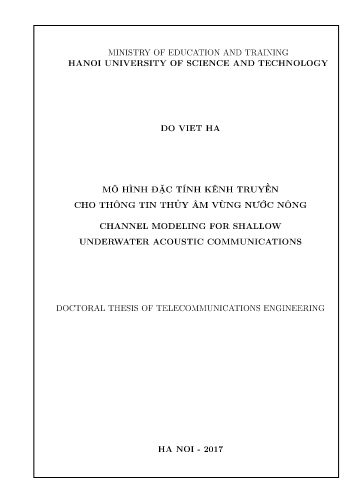
propagation delay τl and the path gain cn;l are deter- mined from the measured PDPρ ^(τl). In particular, the propagation delay τl is derived directly from the measured PDPρ ^(τl), and the path gain cn;l is computed as q cn;l = ρ^(l∆τ) (1.46) for l = 0; 1; :::; L − 1 and Nl is selected the same as that of the conventional measurement-based simulator for the purpose of com- 47 paring the computation complexity. Consequently, the simulation FCF is computed by using the deter- mined parameters fNl; cn;l; τlg as in Eq. 1.44. • Step 4: The parameter optimization method LPNM is applied to estimate the parameters of the simulator. In the proposed simu- lator, a part of parameters, including the path gain cn;l, and the propagation delay τl of all propagation paths, are exploited from the measurement data without applying any optimization method as presented in the step 3. Therefore, there are only the Doppler frequencies fn;l of propagation paths that need to be estimated by minimizing the following cost function 1 2 ∆tmax 3 p 1 Z p ^ E = 4 RHH (∆t) − RHH (∆t) d (∆t)5 ; (1.47) ∆tmax 0 ^ where RHH (∆t) and RHH (∆t) denote the simulation TCF and the reference TCF, which are computed as in Eq. 1.45 and Eq. 1.43, respectively. The time separation ∆t is set as the measurement data. As a result, the set of channel parameters fNl; cn;l; fn;l; τlg are deter- mined with fewer channel parameters that are requested to be estimated than those of the conventional simulator. Specifically, in the proposed simulator, the number of channel parameters that need to be estimated are equal to L×Nl; whereas those of the conventional one are 3×L×Nl. In other words, the proposed simulator is computationally simpler than the conventional measurement-based one because of reducing the num- ber of estimated parameters by one third. b) Results and Discussions 48 (a) 1 0.8 0.6 0.4 0.2 Normalized T-FCF 0 500 1.5 1 0 0.5 0 -500 -0.5 ∆ -1 f [Hz] -1.5 ∆ t[s] (b) 1 0.8 0.6 0.4 0.2 Normalized T-FCF 0 500 1.5 1 0 0.5 0 -500 -0.5 ∆ -1 f [Hz] -1.5 ∆ t[s] Figure 1.16: a) The reference T-FCF derived from the measurement results. b) The T-FCF of the channel simulation model designed by the proposed sim- ulator. 1.5 1 0.5 Reference T-FCF Proposed simulation T-FCF 0 t [s] ∆ -0.5 -1 -1.5 -800 -600 -400 -200 f [Hz] 0 ∆ 49 200 400 600 1 0 0.8 0.6 0.4 0.2 800 Normalized T-FCF T-FCF Normalized Figure 1.17: The comparison between the normalized T-FCF of the reference model and that obtained by the proposed simulator. 50 Table 1.3: The performance comparison of the simulation approaches. Approaches of designing The conventional The proposed approach simulators approach Optimization Yes Yes computation methods The PDP and the The PDP and the Doppler power spectrum Doppler power spectrum Input data of the measured UWA of the measured UWA channel channel Number of channel All parameters of Only Doppler frequencies parameters to be propagation paths of propagation paths fn;l estimated fNl; cn;l; fn;l; τlg MSE 0:0030 0:0042 For evaluating the performance of the proposed channel simulator, its statistical characteristics are compared to those of the real UWA channel achieved from our experiments. Figure 1.16 a and 1.16 b show the reference T-FCF and the simulation T-FCF obtained by the proposed simulator, respectively. In more details, Fig. 1.17 plots these T-FCF in the same graph for these comparison, it can be seen a good match between them. Therefore, the channel simulation model obtained by the proposed UWA simulator can describe well the measured UWA channel. To compare the accuracy of the proposed simulator to that of conven- tional one, the different between the simulation T-FCF and the reference T-FCF is calculated and plotted as in Fig. 1.18. It can be seen that our proposed simulator has the accuracy almost equivalent to that of the conventional one. In more details, the results of MSEs (Mean Square Errors) of the T-FCF and the performance comparison of the simulation approaches are presented in Table 1.3. 1.7. Conclusions The two typical approaches, geometry-based and measurement-based, of designing UWA channel simulators have been analyzed. The perfor- mance of each approach is evaluated by comparing its statistical char- acteristics with those of the real measured UWA channel. The results show that the geometry-based approach is simpler in computation be- cause it requires an estimate of a fewer number of channel parameters than the measurement-based one; however, this approach lacks closeness 51 (a) 0.12 0.1 0.08 0.06 0.04 Error T-FCF 0.02 0 500 1.5 1 0 0.5 0 -500 -0.5 ∆ -1 f [Hz] -1.5 ∆ t[s] (b) 0.12 0.1 0.08 0.06 0.04 Error T-FCF 0.02 0 500 1.5 1 0 0.5 0 -500 -0.5 ∆ -1 f [Hz] -1.5 ∆ t[s] Figure 1.18: a) The error of the simulation T-FCF designed by the conventional measurement-based simulator. b)The error of the simulation T-FCF designed by the proposed simulator. 52 to the real UWA channel. The time and spatially varying characteris- tics of the shallow UWA propagation environments lead to difficulties in fitting the geometrical model to the real UWA propagation conditions. Nevertheless, it is noteworthy that the designed channel models using this approach can be utilized for parameter studies. On the contrary, the measurement-based simulator is well-matched with the real mea- sured UWA channel, but the computation effort to estimate the large number of the channel parameters makes this simulator complex. There- fore, we propose the effective channel simulator, whose parameters can be directly exploited from the measured PDP of the real UWA chan- nel. Furthermore, by comparing its statistical properties to those of the real UWA channel, the results show that the proposed channel simula- tor provides the performance which is almost equivalent to that of the conventional one. It should be mentioned that the proposed simulator has been derived from the measurement data of the shallow UWA chan- nel. Therefore, the obtained channel simulation model is only valid for the specific location on which the measurement data have been taken. This chapter sheds light on the major contributions of [J2]. Further- more, the geometry-based UWA channel model is used in [C1], while the measurement-based one is addressed in [J1],[J2]. Chapter 2 MODELING OF DOPPLER POWER SPECTRUM FOR SHALLOW UWA CHANNELS In this chapter, a closed-form expression of Doppler power spectrum model is proposed for shallow underwater acoustic (UWA) channels. Us- ing the geometry model for shallow UWA channels, the theoretical back- ground of Doppler effects generated by the transmitter/receiver (Tx/Rx) movement, or by the motion of sea-surface has been analyzed. As a re- sult, the Doppler power spectrum can be modeled as a summation of the Spike-shape and the Gaussian-shape. The Spike-shape presents the Doppler component from the Tx/Rx movement, while the Gaussian- shape presents the Doppler component from the sea-surface motion. The proposed model is validated through curve fitting with the Doppler power spectrum measurement results of a real shallow UWA channel in Halong bay, Vietnam. The optimal parameters of the proposed model are derived from the measurement results by applying an optimization algorithm called the Lp-norm method. The curve fitting results show that our proposed model matches well with the measurements. There- fore, the proposed Doppler model can accurately describe the Doppler effects for shallow UWA channels. The proposed model can be used to design UWA channel simulators for the performance evaluation of UWA communication systems. 2.1. Introduction In UWA communication systems, the Doppler effect is a severe prob- lem, because of the following reasons: the low speed of sound, the water surface motion, and the large Doppler frequencies compared to the car- rier frequency. Specifically, the Doppler shifts result from the relative Tx/Rx movement and the random motion of sea-surface [9, 21]. Because 53 54 the sea-surface moving is a fast-time variant process, the corresponding Doppler shifts have unpredictable values. Consequently, it is difficult to recognize these Doppler shifts from the measured Doppler spectrum and to compensate for Doppler in communication receivers [95]. Therefore, these Doppler shifts should be considered even though they are less than those caused by the relative Tx/Rx movement [42]. In this chapter, the Doppler effect in UWA communication systems is investigated as a combination of Doppler shifts due to the relative Tx/Rx movement and the sea-surface motion, then a proposal of Doppler spectrum model for UWA channels is given. The Doppler power spectrum represents the time variant characteristics of channels; thus, plays an important role in designing UWA channel simulators and in evaluating the UWA commu- nication system performance. Furthermore, the inter-carrier interference (ICI) resulting from the Doppler effect in UWA-OFDM systems can by analyzed by using the Doppler spectrum model. Based on the analytical results, Doppler compensation algorithms can be proposed. In some earlier research papers [52, 61, 91], the Doppler effect from the surface motion in UWA channels was investigated for the case of the fixed Tx/Rx. In [61], the power spectra density (PSD) of received signal was obtained by relating to the PSD of source, the wave spectrum of the surface, and also the geometry. The author in [91] used three different surface models to compute the Doppler asymmetries of received signal af- ter being scattered from a wind-driven surface. However, a clear relation between the Doppler asymmetry amount and the surface parameters has not been found. In summary, all of these papers evaluated the Doppler spectrum by using the geometrical parameters of the water surface, but these parameters are unstable and changed by complex environment con- ditions of shallow UWA channels. Thus, it is difficult to determine these parameters for obtaining the Doppler spectrum. Furthermore, these studies have not considered the Doppler effect from the surface motion in the combination with that from the relative Tx/Rx movement. The Doppler power spectrum of UWA channels for the case of moving Tx/Rx is considered in many recent studies [22, 29, 39, 44, 47, 48, 90]. In [22, 47], the Doppler spectrum is assumed to be the classical Jakes distribution, 55 the uniform distribution, or the two-path model. Apart from that, most recent studies have computed the Doppler power spectrum using the time-varying channel impulse response (TVCIR) of the measured UWA channels [29, 39, 44, 48, 90]. In [44, 90], the authors assumed that the UWA channels have the wide-sense stationary uncorrelated scattering (WSSUS) property. Consequently, the Doppler power spectrum is ob- tained by the Fourier transform of the autocorrelation function (ACF) of the received signal. Nevertheless, in the condition of fast time-varying UWA channels, the WSSUS assumption is no longer maintained [95]. Besides the method of using the ACF, the Doppler power spectrum can be derived from the measured scattering function of the UWA channels [29], or from the received signal by applying a technique called Time Windowed Doppler Spectrum [39]. The main feature of these methods is to derive the Doppler power spectrum from the measurement data; however, the influence of Doppler shifts due to the relative Tx/Rx move- ment and sea-surface motion in establishing the Doppler spectrum is not analyzed. Thus, a mathematical close-form of Doppler spectrum model for general cases has not been obtained. In this chapter, the Doppler effects in shallow UWA are investigated analytically channels as a combination of the Doppler shifts generated by both the relative Tx/Rx movement and the sea-surface motion. Firstly, the theoretical background of Doppler effects for UWA channels is an- alyzed using a geometry model for shallow environments. The Doppler shifts are addressed and calculated, then a proposal of Doppler spec- trum model for UWA channels is given. The proposed model describes the Doppler power spectrum by a summation of the Spike-shape and Gaussian-shape Doppler spectrum. Specifically, the Spike-shape repre- sents the Doppler shifts caused by the Tx/Rx motion, while the Gaussian- shape represents those caused by the surface motion. The proposed model is validated through curve fitting with the mea- surement results of Doppler power spectrum for a realistic shallow UWA channel in Halong bay, Vietnam. For generating Doppler effects, the measurements have been carried out for the case of fixed Tx and moving Rx in three different scenarios. The received signal was processed by 56 using the concept of the spectrogram, and then the time-varying mea- sured Doppler power spectrum for the UWA channel is produced. Sub- sequently, optimal parameters of the proposed model are derived from the measurement data by applying an optimization algorithm called the Lp-norm method (LpNM). Finally, the curve fitting results show that our proposed model is well matched with the measurement results. The rest of this chapter is organized as follows: In Sect. 2.2, we pro- pose a mathematical Doppler spectrum model based on the analysis of Doppler effects for UWA channels. The description of three different scenarios for measuring Doppler spectrum in the UWA channel is given in Sect. 2.3. Sect. 2.4 illustrates the method to compute the parameters of the proposed model. The measurement and Doppler modeling results are shown in Sect. 2.5. Finally, Sect. 2.6 draws some conclusions. 2.2. The Proposed Doppler Spectrum Model 2.2.1. The Doppler Effects in Shallow UWA Channels For analyzing the theoretical background of Doppler effects in UWA channels, the geometry model in a 3-D coordinate system for a shal- low water environment is considered in Fig. 2.1, which has been ex- tended from the 2-D model in [55]. The scatterers Si;n (n = 1; 2; :::; Ni and i = 1; 2) are assumed to be randomly distributed on the surface (i = 1) and the bottom (i = 2) of the shallow-water environment. It is noticed that the distribution of the scatterers is not assumed to be equally spaced as in Sect. 1.3. The scattering mechanisms and their contributions to the Doppler spectral are considered in Sect. 2.2.2. The angle-of-arrival (AOA) of the nth path is denoted by αi;n. In our con- sidered scenario, the Tx is fixed and the Rx is moving with speed VR R in the direction determined by the angle-of-motion αV . The symbol VSn denotes the surface-normal velocity (i.e. the velocity component in the normal direction to the surface) of the scatterer S1;n on the surface. The surface-normal velocity can be obtained by using the sea surface wave model. However, our paper does not calculate this velocity, we aim to evaluate the Doppler shift caused by this velocity. 57 Figure 2.1: The 3-D geometry model for shallow environments with randomly dis- tributed scatterers Si;n (•) on the surface (i = 1) and the bottom (i = 2). In situations with Tx/Rx movement and/or sea-surface motion, prop- agation paths hve different Doppler frequency shifts that depend on the angles of propagation paths [48, 82]. These angles αi;n, θSn , and θRn are illustrated in Fig. 2.1. The Doppler shift of each path will be considered in the following subsections. a) The Doppler Shifts Caused by the Surface Motion Consider a scatterer S1;n moving in the surface, the transmitted signal is reflected by the scatterer before receiving at the Rx. At each scatterer, we will consider the Doppler shifts generated by the scatterer motion with respect to both received and reflected signals [67]. Therefore, there are two different Doppler frequency shifts generated by the scatterer moving. The first one is caused by the scatterer S1;n movement with respect to the Tx, while the second one results from the scatterer S1;n movement respect to the Rx. These two Doppler shifts are not the same because of depending on which is moving, the source or the observer. We will analyze the two Doppler shifts of nth path as follows. The scatterer S1;n is considered as an observer when moving with 58 respect to the Tx. Thus, the movement will result in a Doppler frequency shift fTxSn expressed as fc × VSn fTxSn = cos θSn ; (2.1) cs where θSn is the angle between the surface-normal velocity VS;n and the scatterer-transmitter axis, the speed of sound cs is given by 1500 m/s, and fc is the carrier frequency. Experienced by the Doppler shift fTxSn , the frequency of signal re- ceived at the scatterer is (fc + fTxSn ). The signal is then reflected to the Rx. When moving with respect to the Rx, the scatterer S1;n is consid- ered as a source. Hence, the signal received at Rx will be affected by an additional Doppler shift fSnRx obtained by VSn cos θRn fSnRx = (fc + fTxSn ) × ; (2.2) cs − VSn cos θRn where θRn is the angle between the surface-normal velocity VS;n and the scatterer-receiver axis. As a result, the total Doppler shift fD;Sn generated by the scatterer S1;n movement is a summation of the two Doppler shifts, fTxSn and fSnRx, expressed as fD;Sn = fTxSn + fSnRx = fc×VSn (cos θSn +cos θRn ) (2.3) cs−VSn cos θRn b) The Doppler Shifts Caused by the Rx Movement After transmitted by the Tx, and then reflecting from scatterers Si;n at the surface (i = 1) or at the bottom(i = 2), the signals are received at Rx. Each propagation path can have a different Doppler shift depending on its angle-of-arrival (AOA) αi;n. Referring to the geometry model in Fig. 2.1, the Doppler shift fi;n of nth propagation path resulting from Rx movement is calculated by fi;n = fD;max cos (αi;n) ; (2.4) where fD;max denotes the maximum Doppler frequency shift resulting from the Rx movement. 59 2.2.2. The Proposed Doppler Model for UWA Channels The purpose of this study is to define a Doppler spectrum model that fits in with the measured Doppler spectrum of the real UWA channel. The Doppler spectrum model should consist of two Doppler components caused by the surface motion, and by the relative Tx/Rx movement. Each of component is analyzed in the following subsections. a) The Model of Doppler Component from the Surface Motion Scattering from sea-surface can occur in three different mechanisms, which are Bragg, Burst (also known as sea spikes), and Whitecap scat- tering. Each of scattering mechanisms and its relation to the qualitative Doppler spectra that contributes to the scattered signal are described in [98, 99, 100]. There are several mathematical Doppler models given by Lee [45], Walker [98, 99], and Ward et al. [100] for radar Doppler spectra. In all of them, the Walker model considers the overall Doppler spectrum resulting from Bragg, Whitecap, and Burst scattering, as a summation of only Gaussian line-shapes. The Gaussian basic function represents scattering mechanisms from scatterers with Doppler broadening caused by a spread in their speeds [77]. The mechanisms are similar to those from scatterers moving on the surface that have fast-time variant ve- locities. Therefore, this Gaussian function is well-suited to describe the Doppler component SSurface (f) due to the surface motion, expressed as [98] 2 1 − f−fm S (f) = p e ( w ) ; (2.5) Surface w π where w is the spectral bandwidth, and fm is the Doppler shift resulting from the surface motion. Each scatterers S1;n moving on the water sur- face with a spread in its speed VSn generates the
File đính kèm:
 luan_an_mo_hinh_dac_tinh_kenh_truyen_cho_thong_tin_thuy_am_v.pdf
luan_an_mo_hinh_dac_tinh_kenh_truyen_cho_thong_tin_thuy_am_v.pdf 2.Tom tat luan an_English.pdf
2.Tom tat luan an_English.pdf 2.Tom tat luan an_Vietnamese.pdf
2.Tom tat luan an_Vietnamese.pdf 3. Ban trich yeu luan an.pdf
3. Ban trich yeu luan an.pdf 4. INFORMATION ON NEW CONCLUSIONS OF DOCTORAL THESIS.pdf
4. INFORMATION ON NEW CONCLUSIONS OF DOCTORAL THESIS.pdf 5. THÔNG TIN TÓM TẮT VỀ NHỮNG KẾT LUẬN MỚI CỦA LUẬN ÁN TIẾN SĨ (VIỆT).pdf
5. THÔNG TIN TÓM TẮT VỀ NHỮNG KẾT LUẬN MỚI CỦA LUẬN ÁN TIẾN SĨ (VIỆT).pdf

